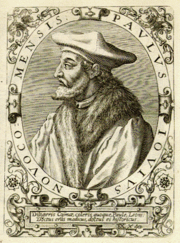
Paolo Giovio.

Monument to Paolo Giovo by Francesco da Sangallo, in San Lorenzo Basilica, Florence.
Paolo Giovio (also spelled Paulo Jovio; Latin: Paulus Jovius) (April 19, 1483 – December 11, 1552) was an Italian physician, historian, biographer, and prelate.
He is chiefly known as the author of a celebrated work of contemporary history, Historiarum sui temporis libri XLV, of a collection of lives of famous men, Vitae virorum illustrium (1549‑57), and of Elogia virorum bellica virtute illustrium, (Florence, 1554), which may be translated as Praise of Men Illustrious for Courage in War (1554). He is best remembered as a chronicler of the Italian Wars. His eyewitness accounts of many of the battles form one of the most significant primary sources for the period.
Biography[]
Little is known about Giovio's youth. He was a native of Como; his family was from the Isola Comacina of Lake Como. His father, a notary, died around 1500. He was educated under the direction of his elder brother Francesco, a humanist and historian. Although interested by literature, he was sent to Padua to study medicine. He graduated in 1511.
He worked as physician in Como but, after the spreading of the plague in that city he moved to Rome, settling there in 1513. Pope Leo X assigned him a cathedra of Moral Philosophy and, later, that of Natural Philosophy in the Roman university. He was also knighted by the Pope.[1] In the same period he started to write historical essays. He wrote a memoir of Leo soon after his death.
In 1517 he was appointed as personal physician by the Cardinal Giulio di Giuliano de' Medici (the future pope Clement VII). In the field he wrote some treatises, like the De optima victus ratione, in which he expresses his doubts about the current pharmacology, and the need to improve prevention before the cure. He helped Clement VII during the 1527 sack of Rome. From 1526 to 1528, he stayed on the island of Ischia as Vittoria Colonna's guest.[2] In 1528, he became bishop of Nocera de' Pagani. Giovio wrote an account of Dmitry Gerasimov's embassy to Clement VII, which related detailed geographical data on Muscovy.
In 1536 Giovio had a villa built for him on Lake Como, which he called Museo, and which he used for his collection of portraits of famous people. After Clement's death, he had retired. As well as paintings, he sought antiquities, etc., and his collection was one of the first to include pieces from the New World. A set of copies of the paintings from the collection, now known as the Giovio Series, is on display in the Uffizi Gallery. In 1549 Pope Paul III denied him the title of Bishop of Como, and he decided to move to Florence, where he died in 1552.
Works[]
- De romanis piscibus (1524)
- De legatione Basilii Magni Principis Moschoviae (1525)
- Commentario de le cose de’ Turchi (1531)
- Elogia virorum litteris illustrium or Elogia doctorum virorum (1546)
- Descriptio Britanniae, Scotiae, Hyberniae et Orchadum (1548)
- Vitae (1549)
- Pauli Jovii historiarum sui temporis (1550–52)
- Elogia virorum bellica virtute illustrium (1554), as an eye witness of many people involved in the Italian Wars including Gonzalo Fernández de Córdoba
- Dialogo dell'imprese militari et amorose (1555)
References[]
- ↑ Schlager, Patricius (12 July 2013). "Paulus Jovius". Catholic Encyclopedia. New York: Robert Appleton Company. http://www.newadvent.org/cathen/08530b.htm.
- ↑ Zimmerman, T. C. Price (1995). "Ischia, 1527-1528". Princeton University Press. pp. 86–105. ISBN 9781400821839. http://books.google.com/books?id=sXrVSfSMu9gC.
- Oman, Charles (1937). A History of the Art of War in the Sixteenth Century. London: Methuen & Co..
- Zimmerman, T. C. (1995). Paolo Giovio: The Historian and the Crisis of Sixteenth-Century Italy. Princeton, NJ: Princeton University Press. ISBN 9781400821839. http://books.google.com/books?id=sXrVSfSMu9gC&dq.
- Giovio, Paolo (2013). Gouwens, Kenneth. ed. Notable Men and Women of Our Time. The I Tatti Library. Cambridge, MA: Harvard University Press. ISBN 9780674055056. http://books.google.com/books/about/Notable_Men_and_Women_of_Our_Time.html?id=lNnRMgEACAAJ.
External links[]
- Article in the Catholic Encyclopedia
- Elogia Doctorum Virorum online (English translation, with life of Paulus Jovius)
- Vita de Leonis X (Latin text)
The original article can be found at Paolo Giovio and the edit history here.